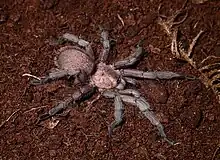| Chaetopelma | |
|---|---|
 | |
| Chaetopelma gracile | |
| Scientific classification | |
| Domain: | Eukaryota |
| Kingdom: | Animalia |
| Phylum: | Arthropoda |
| Subphylum: | Chelicerata |
| Class: | Arachnida |
| Order: | Araneae |
| Infraorder: | Mygalomorphae |
| Family: | Theraphosidae |
| Genus: | Chaetopelma Ausserer, 1871[1] |
| Type species | |
| C. olivaceum (C. L. Koch, 1841) | |
| Species | |
|
7, see text | |
| Synonyms[1] | |
Chaetopelma is a genus of tarantulas that was first described by Anton Ausserer in 1871.[3] They are found in Africa and Asia including the countries of Turkey, Syria, Egypt, Cyprus, Greece, Sudan, Cameroon, and now even Iran.[1]
Diagnosis
They can be distinguished from the other tarantula genera, except from Nesiergus, because the presence of clavate trichobothria in two rows on the tarsi. Males have a tibial apophysis consisting of two branches, females having a long and slender spermatheca.[4]
Species
As of July 2022 it contains seven species, found in Africa, Balkans, on Cyprus, and in Syria:[1]
- Chaetopelma altugkadirorum Gallon, Gabriel & Tansley, 2012 – Turkey, Syria
- Chaetopelma concolor (Simon, 1873) – Turkey, Syria, Egypt
- Chaetopelma karlamani Vollmer, 1997 – Cyprus
- Chaetopelma lymberakisi Chatzaki & Komnenov, 2019 – Greece (Crete)
- Chaetopelma olivaceum (C. L. Koch, 1841) (type) – Cyprus, Turkey, Sudan, Egypt, Middle East
- Chaetopelma persianum Zalmani & West, 2023- northern Zagros Mountains, Iran
- Chaetopelma turkesi Topçu & Demircan, 2014 – Turkey
- Chaetopelma webborum Smith, 1990 – Cameroon
In synonymy:
- C. aegyptiacum Ausserer, 1871 = Chaetopelma olivaceum
- C. anatolicum Schmidt & Smith, 1995 = Chaetopelma olivaceum
- C. gracile (Ausserer, 1871) = Chaetopelma olivaceum
- C. jerusalemensis (Smith, 1990) = Chaetopelma olivaceum
- C. shabati Hassan, 1950 = Chaetopelma olivaceum
- C. syriacum (Ausserer, 1871) = Chaetopelma olivaceum
- C. tetramerum (Simon, 1873) = Chaetopelma olivaceum
Transferred to other genera
- Chaetopelma adenense Simon, 1890 → Ischnocolus jickelii
- Chaetopelma gardineri Hirst, 1911 → Nesiergus gardineri
- Chaetopelma longipes L. Koch, 1875 → Holothele longipes
- Chaetopelma olivaceum (Strand, 1907) → Encyocratella olivacea
- Chaetopelma strandi Schmidt, 1991 → Encyocratella olivacea
See also
References
- 1 2 3 4 "Gen. Chaetopelma Ausserer, 1871". World Spider Catalog Version 20.0. Natural History Museum Bern. 2020. doi:10.24436/2. Retrieved 2020-01-31.
- ↑ Guadanucci, J. P. L.; Gallon, R. C. (2008). "A revision of the spider genera Chaetopelma Ausserer 1871 and Nesiergus Simon 1903 (Araneae, Theraphosidae, Ischnocolinae)". Zootaxa. 1753: 35. doi:10.11646/zootaxa.1753.1.2.
- ↑ Ausserer, A. (1871). "Beiträge zur Kenntniss der Arachniden-Familie der Territelariae Thorell (Mygalidae Autor)". Verhandlungen der Kaiserlich-Königlichen Zoologisch-Botanischen Gesellschaft in Wien. 21: 117–224.
- ↑ Paulo, José; C. Gallon, Richard (2008). "A Revision Of The Spider Genera Chaetopelma Ausserer 1871 And Nesiergus Simon 1903 (Araneae, Theraphosidae, Ischnocolinae)". ResearchGate. Retrieved July 19, 2022.
This article is issued from Wikipedia. The text is licensed under Creative Commons - Attribution - Sharealike. Additional terms may apply for the media files.